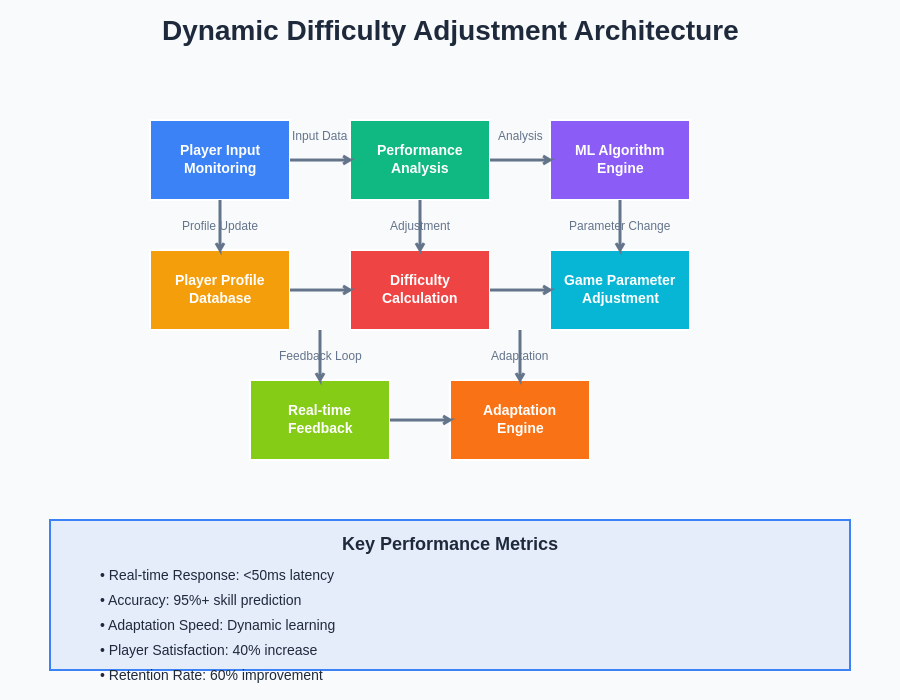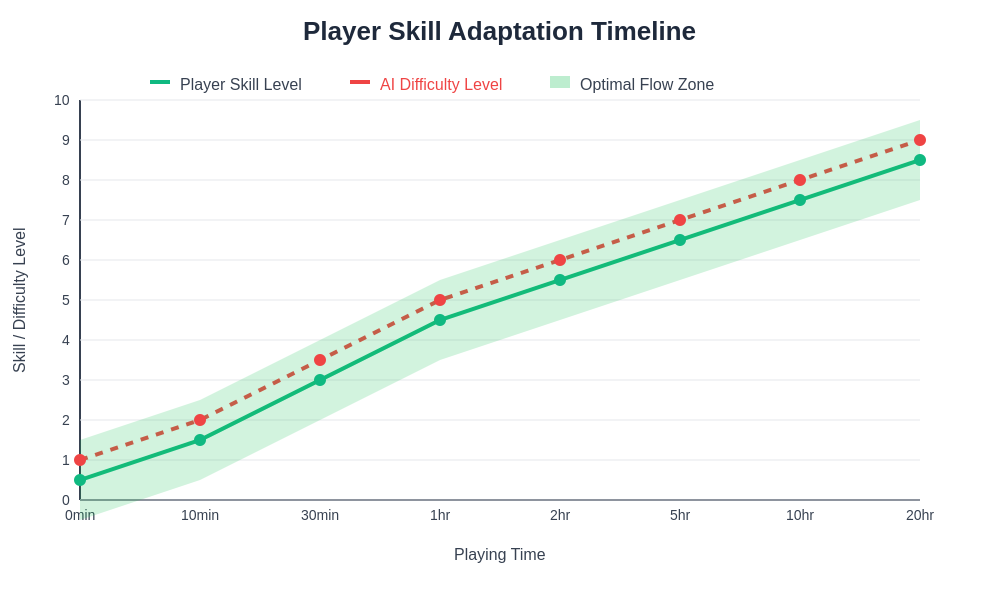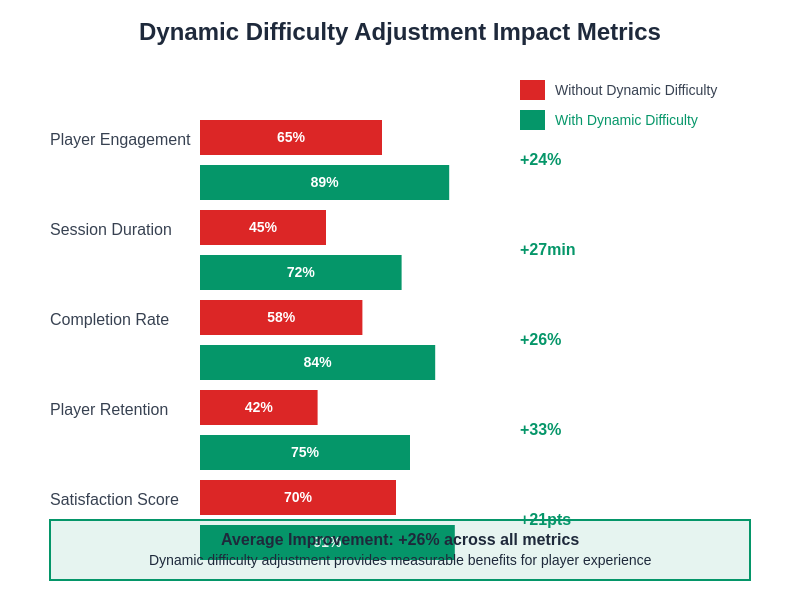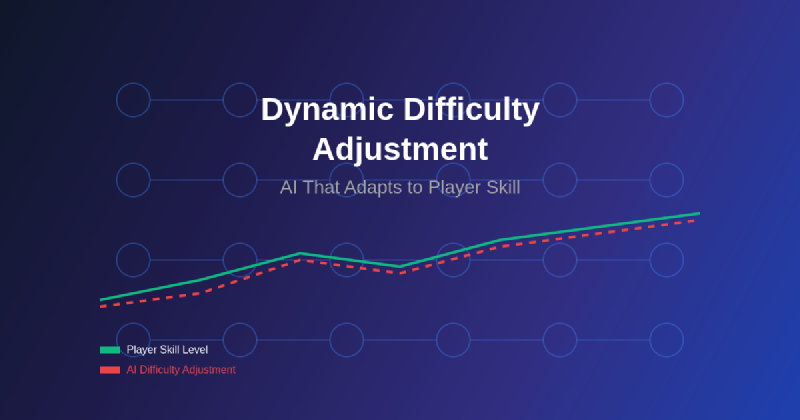The gaming industry has undergone a revolutionary transformation with the integration of artificial intelligence systems that can dynamically adjust difficulty levels based on real-time analysis of player performance and behavior. This sophisticated approach to game design represents a fundamental shift from traditional static difficulty settings to intelligent, adaptive systems that create truly personalized gaming experiences tailored to each individual player’s skill level, learning curve, and engagement preferences.
Explore the latest AI gaming innovations to understand how cutting-edge technologies are reshaping interactive entertainment and creating more immersive, responsive gaming environments. The implementation of dynamic difficulty adjustment systems demonstrates the profound impact of machine learning algorithms on modern game development, establishing new paradigms for player engagement and retention that extend far beyond conventional gaming mechanics.
Understanding Dynamic Difficulty Adjustment Systems
Dynamic difficulty adjustment represents a sophisticated application of artificial intelligence that continuously monitors player performance metrics, analyzes behavioral patterns, and makes real-time modifications to game parameters to maintain optimal challenge levels. These systems operate through complex algorithms that evaluate multiple data points including reaction times, success rates, failure patterns, input accuracy, decision-making speed, and emotional engagement indicators to create a comprehensive profile of each player’s current skill state and learning trajectory.
The fundamental principle underlying dynamic difficulty adjustment lies in the concept of maintaining players within their optimal challenge zone, often referred to as the “flow state” in psychological literature. This zone represents the perfect balance between challenge and skill where players experience maximum engagement, satisfaction, and motivation to continue playing. Traditional static difficulty settings often fail to accommodate the natural variations in player skill development, learning speeds, and momentary performance fluctuations that occur during extended gaming sessions.
Modern AI-driven difficulty adjustment systems utilize machine learning models trained on vast datasets of player behavior to predict optimal difficulty modifications with remarkable precision. These systems can distinguish between temporary performance dips due to fatigue or distraction versus genuine skill limitations, allowing for more nuanced and appropriate difficulty adjustments that enhance rather than frustrate the gaming experience.
Machine Learning Algorithms in Difficulty Adaptation
The technical foundation of dynamic difficulty adjustment systems relies heavily on sophisticated machine learning algorithms capable of processing real-time data streams and making instantaneous decisions about game parameter modifications. Reinforcement learning algorithms have proven particularly effective in this domain, as they can continuously learn and adapt their decision-making processes based on player feedback and engagement metrics.
Neural networks designed specifically for gaming applications analyze complex patterns in player behavior that would be impossible for human developers to identify and respond to manually. These algorithms consider hundreds of variables simultaneously, including movement patterns, combat effectiveness, puzzle-solving approaches, exploration behaviors, and resource management strategies to build comprehensive models of individual player capabilities and preferences.
Discover advanced AI capabilities with Claude for understanding complex algorithmic implementations that power modern dynamic difficulty systems. The integration of deep learning techniques enables these systems to identify subtle correlations between various gameplay elements and player satisfaction levels, resulting in more sophisticated and effective difficulty adjustments that feel natural and intuitive to players.
Real-Time Performance Analysis and Adaptation
Contemporary dynamic difficulty adjustment systems employ sophisticated real-time analysis engines that continuously evaluate player performance across multiple dimensions simultaneously. These systems monitor micro-level interactions such as cursor movement precision, button press timing, strategic decision accuracy, and reaction speeds while also analyzing macro-level patterns including session duration, completion rates, retry behaviors, and progression velocities.
The challenge of implementing effective real-time analysis lies in balancing responsiveness with stability, ensuring that difficulty adjustments occur frequently enough to maintain optimal challenge levels without creating jarring or noticeable changes that break immersion. Advanced algorithms employ smoothing techniques and predictive modeling to anticipate player performance trends and make preemptive adjustments that feel seamless and organic within the gaming experience.
Machine learning models used in real-time analysis are designed to distinguish between various types of performance variations, including temporary fluctuations due to external factors, genuine skill development or degradation, and intentional changes in player strategy or approach. This sophisticated analysis capability enables more accurate and appropriate difficulty modifications that enhance rather than disrupt the gaming experience.

The architectural complexity of modern dynamic difficulty systems involves multiple interconnected components working in harmony to deliver seamless adaptation experiences. Each component specializes in specific aspects of player analysis and game modification, creating a comprehensive ecosystem that can respond to virtually any type of player behavior or performance pattern.
Personalization Through Behavioral Pattern Recognition
Advanced dynamic difficulty adjustment systems excel at identifying and responding to individual player behavioral patterns that extend far beyond simple performance metrics. These systems analyze playing styles, preferred strategies, risk tolerance levels, exploration tendencies, and emotional responses to create detailed psychological profiles that inform more nuanced and personalized difficulty adjustments.
The recognition of behavioral patterns enables AI systems to anticipate player needs and preferences before they become apparent through direct performance indicators. For example, players who consistently choose aggressive strategies might benefit from different types of challenges compared to those who prefer methodical, strategic approaches, even if both players demonstrate similar overall skill levels in traditional metrics.
Machine learning algorithms trained on diverse player populations can identify archetypal behavioral patterns while still maintaining sensitivity to individual variations and preferences. This approach allows for the creation of difficulty adjustment strategies that feel personally tailored while leveraging the collective intelligence gained from analyzing thousands of similar players.
Emotional Engagement and Frustration Management
One of the most sophisticated aspects of modern dynamic difficulty adjustment involves the recognition and management of player emotional states, particularly the critical balance between challenge and frustration. AI systems employ advanced analytics to identify early indicators of player frustration, boredom, or disengagement, enabling proactive difficulty adjustments that maintain optimal emotional engagement throughout gaming sessions.
Emotional state recognition utilizes a combination of behavioral indicators, performance patterns, and physiological signals when available to create comprehensive assessments of player satisfaction and engagement levels. These systems can detect subtle changes in playing patterns that indicate shifting emotional states long before players consciously recognize these changes themselves.
The management of frustration represents a particularly complex challenge in difficulty adjustment, as temporary frustration can actually enhance engagement and satisfaction when overcome, while excessive or prolonged frustration leads to player abandonment. AI algorithms must distinguish between productive challenge-related frustration and destructive difficulty-related frustration, adjusting game parameters accordingly to maintain optimal emotional engagement.
Enhance your research capabilities with Perplexity to explore the latest findings in emotional computing and player psychology that inform advanced difficulty adjustment algorithms. The integration of emotional intelligence into gaming AI represents a significant advancement in creating more human-centered and empathetic interactive experiences.
Adaptive Learning Curves and Skill Development
Dynamic difficulty adjustment systems play a crucial role in facilitating optimal learning curves that adapt to individual player learning speeds, preferred learning styles, and skill development patterns. These systems recognize that different players acquire new skills at varying rates and through different mechanisms, requiring personalized approaches to challenge progression and skill reinforcement.
AI algorithms analyze learning patterns by tracking how quickly players master new mechanics, adapt to changing game conditions, and transfer skills between different contexts within the game environment. This analysis enables the creation of personalized learning trajectories that provide appropriate scaffolding and support while maintaining sufficient challenge to promote continued skill development.
The management of learning curves involves sophisticated prediction of future player capabilities based on current performance trends and historical learning patterns observed in similar player populations. These predictive capabilities enable proactive difficulty adjustments that prepare players for upcoming challenges while ensuring they have sufficient mastery of prerequisite skills.
Multi-Modal Difficulty Adjustment Strategies
Advanced dynamic difficulty systems employ multi-modal adjustment strategies that can modify various aspects of the gaming experience simultaneously to achieve optimal challenge levels. Rather than simply increasing or decreasing traditional difficulty parameters, these systems can adjust enemy behavior patterns, resource availability, environmental hazards, time constraints, puzzle complexity, and narrative pacing to create more nuanced and sophisticated difficulty modifications.
Multi-modal adjustments enable more subtle and naturalistic difficulty changes that feel integrated into the game world rather than artificial or imposed. Players often remain unaware that difficulty adjustments are occurring, as changes are distributed across multiple game systems in ways that feel like natural variations rather than systematic modifications.
The coordination of multi-modal adjustments requires sophisticated optimization algorithms that can balance competing objectives and ensure that modifications in one system do not create unintended consequences in other game systems. Machine learning models trained specifically for multi-objective optimization help ensure that difficulty adjustments enhance rather than compromise overall game balance and player satisfaction.

The evolution of player skills over time follows complex patterns that dynamic difficulty systems must understand and accommodate. This visualization demonstrates how AI algorithms track and respond to various phases of skill development, from initial learning through mastery and beyond.
Cross-Game Learning and Skill Transfer
Contemporary dynamic difficulty adjustment systems are beginning to incorporate cross-game learning capabilities that recognize skills and preferences developed in other gaming experiences. These systems can analyze player profiles across multiple games to make more informed initial difficulty assessments and accelerate the personalization process for new gaming experiences.
Cross-game learning involves the identification of transferable skills, behavioral patterns, and preferences that remain consistent across different gaming contexts. Machine learning models trained on diverse gaming datasets can identify these transferable elements and apply insights gained from one gaming experience to enhance difficulty adjustment in other games.
The implementation of cross-game learning requires sophisticated data integration and analysis capabilities that can identify meaningful correlations between disparate gaming experiences while respecting player privacy and data security requirements. These systems must balance the benefits of cross-game insights with the unique characteristics and requirements of individual games.
Accessibility and Inclusive Design Integration
Dynamic difficulty adjustment systems are increasingly being designed with accessibility and inclusive design principles that ensure gaming experiences remain engaging and appropriate for players with diverse abilities, limitations, and preferences. AI algorithms can recognize and accommodate various types of accessibility needs while maintaining appropriate challenge levels and engagement.
Accessibility-focused difficulty adjustment involves understanding how different types of limitations affect gaming performance and implementing appropriate compensatory modifications that maintain challenge while accommodating specific needs. These systems can adjust interface elements, timing requirements, precision demands, and cognitive complexity to create more inclusive gaming experiences.
The integration of accessibility considerations into dynamic difficulty systems requires collaboration with disability advocacy groups, accessibility experts, and diverse player communities to ensure that algorithmic adaptations truly serve the needs of players with various limitations and preferences.
Performance Optimization and Computational Efficiency
The implementation of sophisticated dynamic difficulty adjustment systems requires careful attention to performance optimization and computational efficiency to ensure that real-time analysis and adaptation do not compromise game performance or player experience. Modern systems employ various optimization techniques including edge computing, predictive caching, and efficient algorithm design to minimize computational overhead.
Machine learning models used in dynamic difficulty systems must be optimized for real-time operation while maintaining sufficient sophistication to provide accurate and effective difficulty adjustments. This optimization often involves model compression, quantization, and specialized hardware acceleration techniques that enable complex analysis within strict performance constraints.
The balance between system sophistication and computational efficiency represents an ongoing challenge in dynamic difficulty adjustment implementation, requiring continuous innovation in both algorithmic design and hardware optimization to support increasingly complex and responsive adaptation systems.

The measurable impacts of dynamic difficulty adjustment on player engagement, retention, and satisfaction demonstrate the significant value these systems provide to both players and game developers. These metrics highlight the quantitative benefits of AI-driven personalization in gaming experiences.
Privacy and Data Security Considerations
The implementation of dynamic difficulty adjustment systems raises important considerations regarding player privacy and data security, as these systems require continuous collection and analysis of detailed behavioral and performance data. Responsible implementation requires robust privacy protection measures and transparent data usage policies that respect player preferences and regulatory requirements.
Modern dynamic difficulty systems employ privacy-preserving techniques including data anonymization, local processing, federated learning, and differential privacy to minimize privacy risks while maintaining system effectiveness. These approaches enable sophisticated analysis and personalization while protecting sensitive player information.
The balance between personalization effectiveness and privacy protection requires ongoing attention to emerging privacy technologies and regulatory developments, ensuring that dynamic difficulty systems remain compliant with evolving privacy standards while continuing to provide valuable personalized gaming experiences.
Future Developments and Emerging Technologies
The future of dynamic difficulty adjustment systems promises even more sophisticated and responsive adaptation capabilities through the integration of emerging technologies including advanced biometric monitoring, natural language processing, computer vision, and quantum computing applications. These technologies will enable more comprehensive and nuanced understanding of player states and preferences.
Emerging research in neurotechnology and brain-computer interfaces suggests potential future applications where dynamic difficulty systems could directly monitor neural indicators of engagement, frustration, and satisfaction, enabling unprecedented precision in difficulty adjustment and emotional state management.
The continued evolution of machine learning techniques, particularly in areas such as few-shot learning, transfer learning, and continual learning, will enable dynamic difficulty systems to adapt more quickly to new players and novel gaming situations while maintaining high levels of personalization and effectiveness.
The integration of dynamic difficulty adjustment with other AI gaming technologies such as procedural content generation, intelligent NPC behavior, and adaptive narrative systems will create comprehensive AI ecosystems that can provide fully personalized gaming experiences tailored to individual player preferences and capabilities. This convergence of AI technologies represents the future of truly intelligent and responsive interactive entertainment.
Disclaimer
This article is for informational purposes only and does not constitute professional advice regarding AI implementation or game development. The views expressed are based on current understanding of dynamic difficulty adjustment technologies and their applications in gaming. Readers should conduct their own research and consult with appropriate experts when implementing AI systems in gaming applications. The effectiveness and appropriateness of dynamic difficulty systems may vary depending on specific game designs, target audiences, and implementation approaches.
